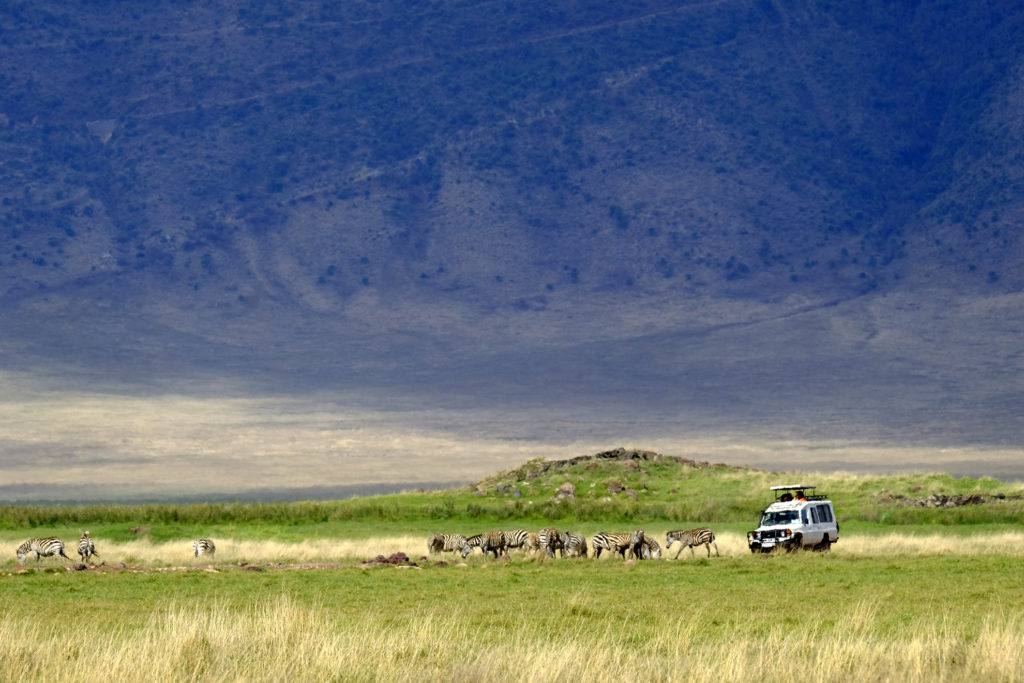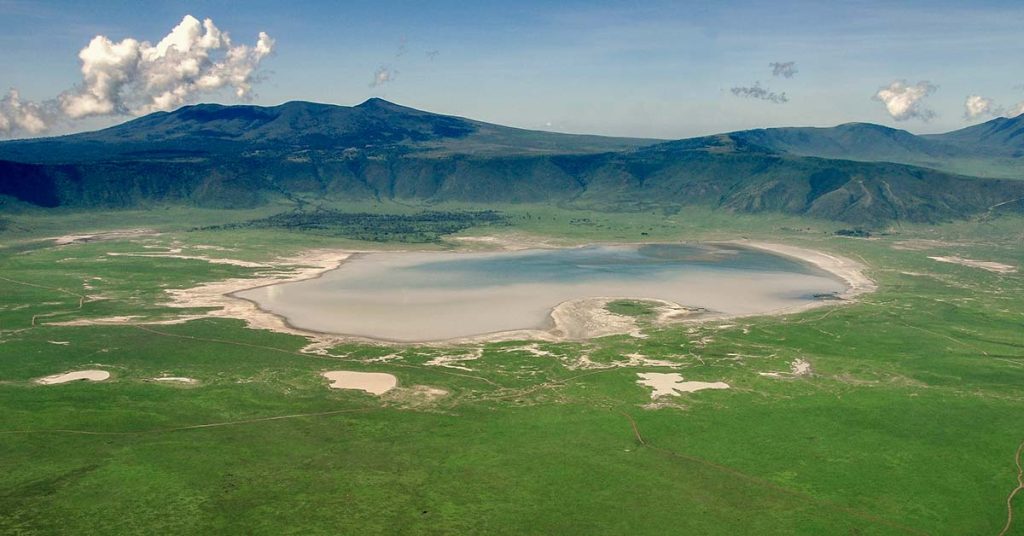Ngorongoro Crater Conservation Area, Size, Animals & History:
Ngorongoro Crater, a wildlife conservation area in northern Tanzania in the crater highlands is a centerpiece of wildlife picturesque. It deprives its name from the large volcanic caldera in this geological area, the Ngorongoro crater. It was established in 1959 as a UNESCO world Heritage Site under the governance of Ngorongoro Conservation Area Authority.
This conservation area is 180 km west of Arusha city in Ngorongoro District, 327.3 km from the capital city Dodoma. It is a home to a variety of wildlife species on its magnificent 8,292 km2 of space. The park is quite a big one and harbors numerous troops of elephants, herds of herbivores, prides of lions, bloats of hippos, flocks of birds and much more species.
The Ngorongoro Crater Conservation Area holds impressive significance on sustainable tourism in Tanzania. Its ecological factors, cultural and historical importance are key aspects towards the wildlife conservation efforts. This cultural heritage site is an example of the perfect correlation of nature and human company.
Entrance fees at this park are structured as follows;
- East Africans above 16 pay 35400 Tsh each whereas foreigners pay 59 USD
- East Africans below 16 pay 11800 Tsh each whereas foreigners pay 12 USD
- Children below 5 do not pay.
Tourist attractions at Ngorongoro Crater Conservation Area.
- The Ngorongoro Crater
- The Olduvai Gorge
- Empakaai Crater
- Lerai Forest
- Lake Magadi
- The Malanja Depression
- The Big five, e. lions, elephants, hippos, leopards, buffaloes, and bird species.
Activities at Ngorongoro Conservation Area.
There are a number of exhilarating activities tourists should await at their visit to this conservation area. These activities are well coordinated with experienced tour guides, park rangers with safety measures and detailed brochures to make the explorations in this area immersive and invulnerable.
These activities portray the best picture of the vast biodiversity this park is rich in like the breathtaking landscapes, innumerable wildlife species and the cultural heritages. Among the very many captivating activities in the Ngorongoro, the following are the most enticing.
Things to do in Ngorongoro Conservation Area.
Visiting the Ngorongoro Crater.
This large volcanic caldera is notably among the most visited areas in this park. It encompasses approximately 100 sq mi of grasslands, water streams and swamps. The walks and drives to this crater are guided by certified tour personnel. These guides lead you through the paths on this adventurous trek while detailing all the encountered wildlife.
The Safaris to this crater are in the mornings and in the late afternoons. The early morning ones are usually the most ideal as they are the times when wildlife at this park on the trails is more active. Await encounters of lion prides, elephant troops, hippo bloats, wildebeest treks and various bird flights as you travel to this crater.
The climatic conditions around this crater vary but usually the mornings and evenings are cool. Prepare this adventure by dressing appropriately in light clothes to encounter this beautiful feature comfortably. Visiting this area is free of charge.
Safari Game Drives.
These game drives at Ngorongoro Conservation Area are thrilling adventures where tourists can encounter the extensive array of wildlife in their natural habitats. These Safaris are guided by experts in heavy duty vehicles. These vehicles are all wheel drive making them capable of traversing all kinds of terrain in the park. These vehicles have a pop up roof and clear screen windows making observation of wildlife at this park unobstructed.
A variety of wildlife species is encountered on these drives for example the African buffalos, zebras, giraffes, wildebeests, leopards, lions, birds and other species at close proximity.

These drives are organized in three sessions, namely the morning drives, late afternoon drives and the night drives. All these sessions have the same fees, i.e. 50 USD for adults whereas infants pay 35 USD.
Hot Air Balloon Safaris.
This captivating experience is a unique way to explore the Ngorongoro Conservation Area. Having the panoramic views of the park’s stunning landscapes from above in a round cart raised up by a big gas fueled air balloon is absolutely exhilarating.
This flight is head by trained flight guides that fly you above this park at careful speeds giving you the chance to take overhead pictures of the flora and fauna below you. These guides additionally provide you with relevant insights about the wildlife encountered that you would want to know about.
This over the park excursion is usually geared up early morning when the sun is just coming up and wildlife out for foraging. These morning scenes further entice your adventure at this conservation area on a whole different perspective.
The notable wildlife on this Hot Air Balloon Safari are mainly animals and bird species, but the highlight of the flight is arguably the skeptical sightings of flamingos on Lake Magadi. Enjoy this aerial tour at 450 USD each person, accompanied with an experienced pilot and on flight sumptuous treat.
Guided Nature Walks and Hikes.
These activities are on ground encounters for wildlife, both large and small. The walks are led by park rangers and tour guides very familiar with the park trails. These walks have popular trails with distinctive adventures. One of the most exciting trails is the one that goes to the Empakaai crater. The views around this caldera are stunning with astounding picturesque topping the experience of its lush green forest pathway.
The highlight of this trail sees an extensive exposure of numerous bird species like the endangered Madagascar pond Heron, the Usambara Akalat and the Amani Sunbird. The walks also travel you to the scenic view points of the conservation area where you get to have uncensored scenes of the full beauty of Ngorongoro Conservation Area.
Other interesting activities to do at Ngorongoro Conservation Area include community visits, photography safaris, Masaai Market shopping and wildlife picnics.
Accommodation at Ngorongoro Conservation Area.
At this conservation area, expect to nominate your ideal wildlife abode from a wide list of options. These options are classified into the luxurious accommodation, mid-range options, budget friendly stays and camp sites. These differ in accommodation packages and sustainability, but with unique unmatched experiences.
Best luxury lodges.
The Ngorongoro conservation area has an extensive list of high end accommodation options. They all offer premium services worthy their costs but a bit less substantial than each other.
Entamamu Ngorongoro lodge is far much the best luxurious accommodation option near Ngorongoro. It is just 11 miles far in the Northwest of the Ngorongoro Crater. It has the best luxury endowed rooms made in a theme that relives you of wildlife.
This lodge has an extensive array of amenities and facilities like a fully stacked health club, multi cuisine restaurants, no lag internet connection, and so much more. It tops its uniqueness with exhilarating views of the Ngorongoro Conservation Area in the South west of the lodge.
This high end hotel charges 500 USD for a fully accommodated night of two people in one room. Bookings and reservations for space at this hotel go on at their website or you can book through your trusted tour operator to see availability.
Besides this lodge, you can choose to stay at Neptune Ngorongoro lodge, The Manor lodge or at Ngorongoro Tortilis Camp. These lodges are the other top options in the luxury sector of accommodation at The Ngorongoro Conservation Area.
Best midrange lodge.
Midrange accommodation at Ngorongoro Conservation Area is led by AndBeyond Ngorongoro Crater Lodge. This lodge is at the rim of Ngorongoro Crater themed in love and romance. It’s approximately 20 miles south of the Ngorongoro.
This exquisite setting provides skeptical views of the Ngorongoro crater that is just steps far from it. The rooms for resting are self-contained and elegant. The atmosphere the park surrounds is cheerful during day and colorful in the nights.
Customer care at this lodge is delightful with meals and other services are delivered in time. Expect to pay 300 USD each night for a well packaged accommodation at AndBeyond Ngorongoro Crater Lodge.
Lemala Ngorongoro and Ngorongoro Lodge Melia are the top most alternatives if not comfortable with this lodge.
Best Budget Friendly stays.
Lake Ndutu Tented Lodge is the best budget friendly lodge at Ngorongoro Conservation Area. It is 30 miles far from the park at a well elevated landscape. Its services are slick and affordable. The meals are perfect and the environment I cozy.
The prices per night for a couple at this tented lodge is 40 USD inclusive of meal plans.
Best Times to Visit Ngorongoro Conservation Area.
Northern Tanzania has two weather seasons that impact activities at the Ngorongoro Conservation Area. These seasons, the wet and dry seasons have designated times at which they occur.
The dry season mainly starts from early June to October. In this period the park has dry pathways and shrank vegetation. The skies are very clear and animals roam about everywhere per minute. This is arguably referred to as the best time to take a trip to the park. Wildlife is effortlessly observed on water body banks quenching their thirsts and washing up.
Meanwhile in the wet season Ngorongoro is densely vegetated with lush shrubs and somewhat muddy terrain. This wet season starts from mid-November to late May. During this period the area is often having rains, mild and heavy ones. Surprisingly it is the best time to watch birds, so for bird enthusiasts the wet season got you covered.
On paper, the dry season is more convenient for tourists around the world to visit Ngorongoro Conservation area. The park is more navigable and clear in the dry season than in the wet season. Consider booking your trip to this area in months at which Ngorongoro is clearer.
How to get to Ngorongoro Conservation Area?
On road, the journey stretches to 327.3 km from Dodoma and 180 km from Arusha city in the west. The road network throught the start and end of this journey is perfect and well signaled to direct you to where the Ngorongoro is.
The location of Ngorongoro Conservation Area is accurate on all location servers and GPS operatives. To worry less about road usage and handling on Tanzanian roads, we best advise you to book a car with driver from Your drive Traveling Company and await the most comfortable journey to Ngorongoro.
In conclusion, this conservation area is a hidden gem in Tanzanian efforts towards sustainable tourism activities. It is a remarkable wildlife haven with diverse ecosystems. Its landscapes are breathtaking and weather conditions are amazing.
The native cultures in the park are very hospitable with so much to offer historically and recreationally. It’s an accessible tourist attraction by all modes of transport.

